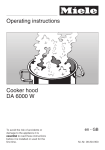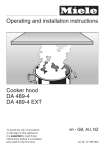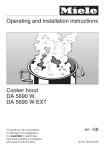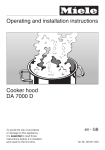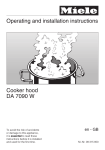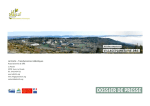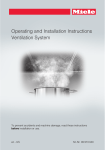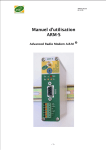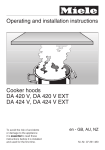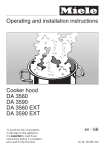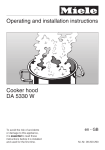Download Miele DA 6000 W
Transcript
Operating and installation instructions Cooker hood DA 6000 W To avoid the risk of accidents or damage to the appliance it is essential to read these instructions before it is installed or used for the first time. en - GB M.-Nr. 07 665 740 Contents Caring for the environment . . . . . . . . . . . . . . . . . . . . . . . . . . . . . . . . . . . . . . . . . . 4 Warning and Safety instructions . . . . . . . . . . . . . . . . . . . . . . . . . . . . . . . . . . . . . 5 How the cooker hood works . . . . . . . . . . . . . . . . . . . . . . . . . . . . . . . . . . . . . . . . 11 Guide to the appliance . . . . . . . . . . . . . . . . . . . . . . . . . . . . . . . . . . . . . . . . . . . . 12 Miele|home . . . . . . . . . . . . . . . . . . . . . . . . . . . . . . . . . . . . . . . . . . . . . . . . . . . . . 14 Con|ctivity . . . . . . . . . . . . . . . . . . . . . . . . . . . . . . . . . . . . . . . . . . . . . . . . . . . . . . 14 Operation . . . . . . . . . . . . . . . . . . . . . . . . . . . . . . . . . . . . . . . . . . . . . . . . . . . . . . . 15 Hinged canopy . . . . . . . . . . . . . . . . . . . . . . . . . . . . . . . . . . . . . . . . . . . . . . . . . . . 15 To switch the fan on s . . . . . . . . . . . . . . . . . . . . . . . . . . . . . . . . . . . . . . . . . . . . . 15 To select a power level . . . . . . . . . . . . . . . . . . . . . . . . . . . . . . . . . . . . . . . . . . . . . 15 Run-on option "5m15" . . . . . . . . . . . . . . . . . . . . . . . . . . . . . . . . . . . . . . . . . . . . . . 16 To switch the fan off s . . . . . . . . . . . . . . . . . . . . . . . . . . . . . . . . . . . . . . . . . . . . . 17 To switch off the fan without closing the canopy . . . . . . . . . . . . . . . . . . . . . . . 17 Hob lighting n . . . . . . . . . . . . . . . . . . . . . . . . . . . . . . . . . . . . . . . . . . . . . . . . . . . 17 Feature lighting ] . . . . . . . . . . . . . . . . . . . . . . . . . . . . . . . . . . . . . . . . . . . . . . . . 18 Operating hours counter l . . . . . . . . . . . . . . . . . . . . . . . . . . . . . . . . . . . . . . . . . . 18 Sensor tones . . . . . . . . . . . . . . . . . . . . . . . . . . . . . . . . . . . . . . . . . . . . . . . . . . . . . 20 For your safety . . . . . . . . . . . . . . . . . . . . . . . . . . . . . . . . . . . . . . . . . . . . . . . . . . . . 21 Safety switch-off for the canopy . . . . . . . . . . . . . . . . . . . . . . . . . . . . . . . . . . . . 21 Safety switch-off for the glass slats . . . . . . . . . . . . . . . . . . . . . . . . . . . . . . . . . 21 Problem. . . . . . . . . . . . . . . . . . . . . . . . . . . . . . . . . . . . . . . . . . . . . . . . . . . . . . . 22 Safety switch-off after 10 hours . . . . . . . . . . . . . . . . . . . . . . . . . . . . . . . . . . . . 22 Cleaning and care . . . . . . . . . . . . . . . . . . . . . . . . . . . . . . . . . . . . . . . . . . . . . . . . 23 Housing . . . . . . . . . . . . . . . . . . . . . . . . . . . . . . . . . . . . . . . . . . . . . . . . . . . . . . . . . 23 Position for maintenance . . . . . . . . . . . . . . . . . . . . . . . . . . . . . . . . . . . . . . . . . . . . 24 To open the housing . . . . . . . . . . . . . . . . . . . . . . . . . . . . . . . . . . . . . . . . . . . . . 24 To close the housing. . . . . . . . . . . . . . . . . . . . . . . . . . . . . . . . . . . . . . . . . . . . . 25 Grease filters . . . . . . . . . . . . . . . . . . . . . . . . . . . . . . . . . . . . . . . . . . . . . . . . . . . . . 25 Resetting the grease filter operating hours counter . . . . . . . . . . . . . . . . . . . . . 26 Cleaning and care . . . . . . . . . . . . . . . . . . . . . . . . . . . . . . . . . . . . . . . . . . . . . . . . 27 Changing a lamp . . . . . . . . . . . . . . . . . . . . . . . . . . . . . . . . . . . . . . . . . . . . . . . . . . 27 After sales service . . . . . . . . . . . . . . . . . . . . . . . . . . . . . . . . . . . . . . . . . . . . . . . . 28 Installation . . . . . . . . . . . . . . . . . . . . . . . . . . . . . . . . . . . . . . . . . . . . . . . . . . . . . . 29 Installation diagram . . . . . . . . . . . . . . . . . . . . . . . . . . . . . . . . . . . . . . . . . . . . . . . . 29 Fixings . . . . . . . . . . . . . . . . . . . . . . . . . . . . . . . . . . . . . . . . . . . . . . . . . . . . . . . . . . 29 2 Contents Appliance dimensions . . . . . . . . . . . . . . . . . . . . . . . . . . . . . . . . . . . . . . . . . . . . . 30 Safety distance between hob and cooker hood (S) . . . . . . . . . . . . . . . . . . . . . 31 Connection for air extraction . . . . . . . . . . . . . . . . . . . . . . . . . . . . . . . . . . . . . . . 32 Condensate trap . . . . . . . . . . . . . . . . . . . . . . . . . . . . . . . . . . . . . . . . . . . . . . . . . . 33 Electrical connection . . . . . . . . . . . . . . . . . . . . . . . . . . . . . . . . . . . . . . . . . . . . . 34 Operation with Control module DSM 400 . . . . . . . . . . . . . . . . . . . . . . . . . . . . . 35 Connection to a window contact switch . . . . . . . . . . . . . . . . . . . . . . . . . . . . . . 35 Potential free connection . . . . . . . . . . . . . . . . . . . . . . . . . . . . . . . . . . . . . . . . . 35 Connection to a light switch . . . . . . . . . . . . . . . . . . . . . . . . . . . . . . . . . . . . . . . 36 Technical data . . . . . . . . . . . . . . . . . . . . . . . . . . . . . . . . . . . . . . . . . . . . . . . . . . . 37 3 Caring for the environment Disposal of the packing material The transport and protective packing has been selected from materials which are environmentally friendly for disposal, and can normally be recycled. Packaging e.g. cling film, polystyrene and plastic wrappings must be kept out of the reach of babies and young children. Danger of suffocation! Disposal of your old appliance Electrical and electronic appliances often contain materials which, if handled or disposed of incorrectly, could be potentially hazardous to human health and to the environment. They are, however, essential for the correct functioning of your appliance. Please do not therefore dispose of it with your household waste. Dispose of or recycle all packaging materials safely as soon as possible. Please dispose of it at your local community waste collection / recycling centre or contact your dealer for advice. Ensure that it presents no danger to children while being stored for disposal. It should be unplugged or disconnected from the mains electricity supply by a competent person. 4 Warning and Safety instructions This appliance complies with all relevant local and national safety requirements. Inappropriate use can, however, lead to personal injury and damage to property. To avoid the risk of accidents and damage to the appliance, please read these instructions carefully before using it for the first time. They contain important information on the safety, installation, use and maintenance of the appliance. Keep these instructions in a safe place and ensure that all users are familiar with the contents. Pass them on to any future owner of the appliance. Correct application ~ This appliance is intended for domestic use only. Any other usage is at the owner's risk and could be dangerous. The manufacturer cannot be held liable for damage resulting from incorrect or improper use or operation. ~ This appliance is not intended for use by persons (including children) with reduced physical, sensory or mental capabilities, or lack of experience or knowledge, unless they are supervised whilst using it or have been shown how to use it correctly by a person responsible for their safety. Safety with children ~ This appliance is not a toy! To avoid the risk of injury, keep children well away and do not allow them to play with it or to use the controls. They will not understand the potential dangers posed by it. They should be supervised whenever you are working in the kitchen. ~ Older children may use the cooker hood only when its operation has been clearly explained to them and they are able to use it safely, recognising the dangers of misuse. ~ Please be aware that on cooker hoods with halogen lighting, the lamps will get very hot during use and remain hot for some time after switching off. To safeguard against burning, keep children well away from the lamps at all times. Technical safety ~ Before installation, check the cooker hood for visible signs of damage. Under no circumstances should you install or use a damaged appliance. A damaged appliance is dangerous. 5 Warning and Safety instructions ~ Before connecting the appliance to the mains supply, make sure that the connection details given on the data plate correspond with the on-site electricity supply; otherwise the appliance could get damaged. Consult a qualified electrician if in any doubt. ~ The electrical safety of this appliance can only be guaranteed when continuity is complete between the appliance and an effective earthing system which complies with current local and national safety regulations. It is most important that this basic safety requirement is present and tested regularly, and where there is any doubt, the household wiring system should be inspected by a qualified electrician. The manufacturer cannot be held liable for the consequences of an inadequate earthing system (e.g. electric shock). ~ For safety reasons, this appliance may only be used when it has been fully installed. ~ Only open the housing as described in the instructions given in the installation sheet and in the Cleaning and care section of this booklet. Under no circumstances should any other parts of the housing be opened. Tampering with electrical connections or components and mechanical parts is highly dangerous to the user, and can cause operational faults. 6 ~ Installation, maintenance and repairs may only be carried out by a Miele authorised person in strict accordance with current national and local safety regulations. Repairs and other work by unqualified persons could be dangerous. The manufacturer cannot be held liable for unauthorised work. ~ A damaged connection cable must only be replaced by an approved and suitably qualified technician. ~ Faulty components must only be replaced by genuine Miele original parts. The manufacturer can only guarantee the safety of the appliance when Miele replacement parts are used. ~ During installation, maintenance and repair work, the appliance must be disconnected from the mains electricity supply. It is only completely isolated from the electricity supply when: – it is switched off at the isolator, or – the screw-out fuse is removed (in countries where this is applicable), or – the mains fuse is disconnected, or – it is switched off at the wall socket and the plug withdrawn, or – the fuse from the fused spur connection unit is withdrawn. Warning and Safety instructions ~ Do not connect the appliance to the mains electricity supply by a multi-socket unit or an extension lead. These do not guarantee the required safety of the appliance (e.g. danger of overheating). Using at the same time as other heating appliances that depend on the air from the room ,Warning - danger of toxic fumes ~ This appliance may only be used in mobile installations such as ships if a risk assessment of the installation has been carried out by a suitably qualified engineer. ~ In areas which may be subject to infestation by cockroaches or other vermin, pay particular attention to keeping the appliance and its surroundings in a clean condition at all times. Any damage which may be caused by cockroaches or other vermin will not be covered by the guarantee. ~ Great care should be taken when using the cooker hood at the same time and in the same room or area of the house as another heating appliance which depends on the air in the room. Such appliances include gas, oil, wood or coal-fired boilers and heaters, continuous flow or other water heaters, gas hobs, cookers or ovens which draw air in from the room and duct exhaust gases out through a chimney or extraction ducting. When used in extraction mode, the appliance draws air in from the room in which it is installed and from neighbouring rooms. If there is insufficient air, an underpressure will occur. The heating appliance may be starved of oxygen, impairing combustion. Harmful gases could be drawn out of the chimney or extraction ducting back into the room, with potentially fatal consequences. 7 Warning and Safety instructions In order to ensure safe operation, and to prevent gases given off by the heating appliances from being drawn back into the room when the cooker hood and the heater are in operation simultaneously, an underpressure in the room of 0.04 mbar (4 pa) is the maximum permissible. One of the following technical measures may be necessary to ensure safe operation. – If the only way of ensuring adequate ventilation is via an open window, a window contact switch should be fitted to ensure that the cooker hood can only operate when the window is opened sufficiently. A window contact switch kit is available from good builders' merchants. Take care when ventilating the room through an open window that ventilation is not impaired by a closed blind or curtain. – The cooker hood can be set up to automatically switch on an air intake fan or open a motorised inlet flap when it is switched on. Ventilation can be maintained by air inlets which cannot be blocked, in windows, doors and outside wall vents, or by other technical measures, such as ensuring that the cooker hood can only be switched on when the heating appliance is switched off or vice versa. A ventilation brick alone is not generally sufficient to ensure safe ventilation. ,The overall ventilation condition of the dwelling must be taken into account. If in any doubt, the advice of a competent builder or, for gas, a qualified gas fitter (registered with an official gas safety body in accordance with national safety regulations), must be sought. 8 – The cooker hood can be set up to automatically switch off a heating appliance which also depends on the air from the room when it is switched on. The Miele DSM 400 control module offers the possibility of combining other components with the cooker hood (see "Operation with Control module DSM 400"). It is available to purchase as an optional extra. If in any doubt, the advice of a competent builder or, for gas, a qualified gas fitter must be sought. Warning and Safety instructions Correct use ~ Always switch the cooker hood on when a cooking zone is in use, otherwise condensation may collect in the hood, which could cause corrosion. ~ The cooker hood is operated by opening the hinged canopy. When opening or closing the canopy, do not place your hand inside the hood or between the glass slats. ~ Do not use pots or pans that are taller than the lower edge of the cooker hood. Opening the canopy could dislodge the pot or pan, or the pot or pan could damage the cooker hood. This rule also applies to other items placed on the hob. ~ When cooking with oil or fat, chip pans and deep fat fryers etc, do not leave the pans unattended. Never leave an open grill unattended when grilling. Overheated oil and fat can ignite and could set the cooker hood on fire. ~ Do not use the cooker hood without the filters in place. This way you will avoid the risk of grease and dirt getting into the appliance and hindering its smooth operation. ~ The filters should be regularly cleaned or changed as appropriate. Saturated filters are a fire hazard. See "Cleaning and care". ~ The cooker hood can get very hot during cooking due to heat rising from the hob. Do not touch the housing or the grease filters until the cooker hood has cooled down. ~ Do not use a steam-cleaner to clean this appliance. Steam could reach the electrical components and cause a short circuit. Correct installation ~ Do not install this cooker hood over a gas hob. ~ Check with the manufacturer of your cooking appliance whether it is safe to install a hood above it. ~ The minimum safety distances between the top of the cooker or hob and the bottom of the cooker hood given in the "Appliance dimensions" section of this booklet must be maintained, unless the hob manufacturer states that a greater safety distance is required. If more than one appliance is fitted beneath the cooker hood, and they have different minimum safety distances to the cooker hood, select the greater distance. 9 Warning and Safety instructions ~ Safety regulations prohibit the fitting of a cooker hood over solid fuel stoves. ~ All ducting, pipework and fittings must be of non-flammable material. These can be obtained from the Miele Spare Parts department or from builders' merchants. ~ The appliance must not be connected to a chimney or vent flue which is in use. Neither should it be connected to ducting which ventilates rooms with fireplaces. ~ If exhaust air is to be extracted into a chimney or ventilation duct no longer used for other purposes, seek professional advice. Accessories ~ Only use genuine Miele spare parts and accessories with this appliance. If spare parts or accessories from other manufacturers are used, this will invalidate the guarantee, and Miele cannot accept liability. The manufacturer cannot be held liable for damage caused by non-compliance with these Warning and Safety instructions. 10 How the cooker hood works When the canopy is tilted forwards, cooking vapours are drawn into the open glass slats, through the grease filters inside the cooker hood and then conducted outside. The re-usable metal grease filters remove solid particles (grease, dust, etc.) from the kitchen vapours, preventing soiling of the cooker hood. The exhaust socket can be fitted with the non-return flap supplied. This flap is closed when the cooker hood is switched off. No exchange of room and outside air can take place. When the cooker hood is switched on, the non-return flap opens for the cooking vapours to be blown directly outside. 11 Guide to the appliance dai2436 12 Guide to the appliance a Position when switched off b Position when switched on f Sensor for the feature lighting Canopy and slats open g Sensor for hob lighting c Position for maintenance This sensor switches the hob lighting on and off, and is also a dimmer switch. Position for cleaning inside the cooker hood, for removing the grease filters and for changing the lamp. h Sensor for switching the fan on and off i Sensors to select the fan power level a Control panel The symbols act as touch controls. Touch the sensors to select the function you require. An audible tone sounds briefly to confirm selection. b Feature lighting The lowest glass slat is illuminated. c Canopy The canopy tilts forward and the glass slats open as soon as the fan or the hob lighting is switched on. j Sensor for the run-on option The fan can be set to switch off automatically after either 5 or 15 minutes. k Touch control for the grease filters The touch control lights up when the grease filters need to be cleaned. The touch control is used to reset the operating hours counter every time the grease filters are cleaned (see "Cleaning and care"). It can also be used to check and alter the operating hours counter. d Hob lighting e Grease filters For information about using the appliance, see "Operation". 13 Miele|home Con|ctivity – When the hob is switched on, the canopy opens, the hob lighting switches on and after a short while the cooker hood fan switches on. dai2405 This cooker hood is communication enabled. + + Communication module XKM 2000 DA a, available as an optional extra, enables the operation of the cooker hood to be automatically controlled by the operating status of a Miele electric hob with onset controls. For communication to take place, the hob must be fitted with communication module XKM 2000 KM b. The hob transmits information about its operating status to the cooker hood via the household power supply (Powerline) c. 14 – During cooking the cooker hood automatically sets its power level according to the number of cooking zones in operation and their power levels. – After switching the hob off, the fan and the hob lighting will switch off automatically after a period of time. The canopy remains open. For detailed information about this function please read the separate instruction booklet supplied with the XKM 2000 DA communication module. The XKM 2000 DA kit is fitted to the cooker hood in the area of the motor and is connected to the controls of the cooker hood. This module must be installed by a Miele service technician or suitably qualified electrician. Operation Hinged canopy The cooker hood is operated by opening the hinged canopy. It opens by touching the On/Off sensor s or the Hob lighting sensor n. It closes by touching the On/Off sensor s. ,When opening or closing the canopy, do not place your hand or catch your fingers inside the hood or between the glass slats. If the cooker hood has been connected to a window contact switch via the Miele DSM 400 control module, the fan cannot be switched on if the window is shut. The On/Off s and 2 sensors flash. If the On/Off sensor s is touched whilst the canopy is opening, the canopy stops. If the On/Off sensor s is touched again, the canopy shuts again. Then the slats extend and close again. To switch the fan on s To select a power level ^ Touch the On/Off sensor s. Depending on the intensity of the cooking vapours, levels 1 to 3 are usually sufficient for normal cooking. ^ Select the level you require by touching the 1, 2 or 3 sensors. Intensive setting ^ For short periods of cooking food with intensive vapours and a strong aroma, e.g. when searing meat, you may wish to select level 4, the Intensive setting. dai2437 The canopy opens and three of the slats extend. The fan then comes on on power level 2. The On/Off s and 2 sensors light up. 15 Operation Automatic switch-off of the Intensive setting Run-on option "5m15" You can set the Intensive setting so that it always only runs for 10 minutes before reverting automatically to level 3. It is advisable to leave the fan running for a few minutes after cooking has finished to neutralise any lingering odours in the air. ^ To set this option, both the fan and the hob lighting must be switched off. The fan can be set to switch off automatically after either 5 or 15 minutes. ^ Touch the Run-on sensor m for approx. 10 seconds until the 1 sensor lights up. ^ Touch in turn – the Hob lighting sensor n, – the 1 sensor, and – the Hob lighting sensor n again. If Automatic switch-off is not activated, the 1 and 4 sensors will flash. ^ Touch the 4 sensor to activate Automatic switch-off. The 1 and 4 sensors will now light up constantly. Touch the 1 sensor to deactivate the Automatic switch-off function. ^ Touch the Run-on sensor m sensor to confirm your selection. If you do not confirm your selection within 4 minutes, the cooker hood will automatically revert to the original setting. 16 ^ After cooking has finished, touch the Run-on option sensor m whilst the fan is still running – – Touch once = The fan will switch off after 5 minutes (5m lights up). – Touch twice = The fan will switch off after 15 minutes (m15 lights up). The canopy will remain open. ^ If you touch the Run-on sensor m again, the fan remains on (5m15 goes out). Operation To switch the fan off s Hob lighting n ^ Touch the On/Off sensor s to switch the fan off. The hob lighting can be switched on and off independently of the fan. The canopy and the slats will close. If the On/Off sensor s is touched whilst the canopy is closing, the canopy will stop and the slats will stay open. If the On/Off sensor s is touched again, the canopy will open again. The slats will shut and then open again. The fan switches on again. To switch off the fan without closing the canopy The fan can also be switched off without closing the canopy (e.g. to be able to continue using the hob lighting). ^ Whilst the fan is running, touch the sensor for the current fan setting for approx. 1 second until the fan switches off. The canopy will remain open. ^ To switch the fan on again, touch one of the fan setting sensors. To switch the hob lighting on ^ Touch the Hob lighting sensor n briefly. If the canopy is closed, it will now tilt forwards and the slats will open. The hob lighting will then switch on at maximum brightness. The Hob lighting sensor n and the On/Off sensor s will light up. To dim the hob lighting The brightness of the hob lighting can be adjusted. ^ With the hob lighting switched on, touch and hold the Hob lighting sensor n. The brightness will gradually dim until you release the sensor. ^ To increase the brightness, touch the Hob lighting sensor n again to the level required, then release it. If you keep your finger on the Hob lighting sensor n, the lighting will continue to change between bright and dim. 17 Operation To switch the hob lighting off Operating hours counter l ^ Touch the Hob lighting sensor n briefly. The canopy will remain open. The number of hours the appliance has been in operation is stored in memory. ^ The light will also switch off if the canopy is closed by touching the On/Off sensor s. The operating hours counter tells you when the grease filters need to be cleaned. Feature lighting ] ^ When the canopy is closed, the lower glass slat can be illuminated by touching the Feature lighting sensor ]. When the canopy is opened, the Feature lighting will switch off. 18 After 30 hours of operation (or another time if the operating hours counter has been altered), the Grease filter sensor l will light up. The grease filters must then be cleaned and the operating hours counter reset (see "Cleaning and Care"). Operation Reading the grease filter operating hours counter Altering the grease filter operating hours counter To check the percentage of time set already used You can set the operating hours counter to suit the type of cooking you do. ^ Press the On/Off sensor s to switch the fan on. Wait until the canopy has opened and the fan is running. ^ Touch and keep your finger on the Grease filter sensor l. One or more of the 1 to 4 sensors will flash. The number of flashing sensors indicates the percentage of the operating time which has already been used up. Sensor 1 Sensors 1 and 2 Sensors 1 to 3 Sensors 1 to 4 = 25 % = 50 % = 75 % = 100 % ^ When you take your finger off the Grease filter sensor l, the current fan setting will show. The number of operating hours used remains in the memory, even when the appliance is switched off or there is a power cut. The operating hours counter is set at the factory for 30 hours. Select a shorter time of 20 hours if you fry a lot. If you only cook occasionally, we still recommend 20 hours because grease which has built up gradually over a long period of time will harden on the grease filters and make cleaning more difficult. If you use very little fat for cooking, select a longer time of 40 or 50 hours. To alter the operating time: ^ Press the On/Off sensor s to switch the fan off. Wait until the canopy is closed and the On/Off sensor s has gone out. ^ Touch the Run-on sensor m and the Grease filter sensor l at the same time. The Grease filter sensor l and one of the fan power level sensors 1 to 4 will flash. The 1 to 4 sensors indicate the time set: 1 = 20 hours 2 = 30 hours 3 = 40 hours 4 = 50 hours 19 Operation ^ Touch the 1 sensor to select a shorter time and the 4 sensor to select a longer time, until the time required has been set. ^ Touch the Grease filter sensor l to confirm your selection. All the lamps will go out. If you do not confirm your selection within 4 minutes, the cooker hood will automatically revert to the original setting. Sensor tones When selecting a function with the sensors, an audible tone will sound briefly to confirm. The audible tone can be deactivated. ^ Switch the fan off by touching the On/Off sensor s. Wait until the canopy has closed and the On/Off sensor s has gone out. ^ Touch the 4 sensor and the Grease filter sensor l at the same time for approx. 5 seconds until a tone sounds briefly. The audible tone is now switched off for all functions. ^ To reactivate the audible tone, repeat the above process. After the cooker hood has been disconnected from the mains electricity supply or after a power cut, the audible tone is activated regardless of the last setting. 20 Operation For your safety The glass slats are spring loaded. They yield if they are blocked by somone's fingers or another object. dai2516 Safety switch-off for the canopy Safety switch-off for the glass slats If the canopy is prevented from closing by someone's hand or an object blocking it, it will be released from the upper locking mechanism, spring open and stop closing. dai2517 The extendable slats also have a release mechanism. If there is a blockage, they might get stuck in the open or shut position. A long audible tone will sound four times. ^ Remove the cause of the blockage. The canopy is now in the "maintenance" position (see "Cleaning and care"). The glass slats will automatically correct themselves when the canopy is opened and shut. ^ Once the obstruction has been removed, the canopy housing must be closed up again (see "Cleaning and care - To close the housing"). ^ Then switch the cooker hood on again by touching the On/Off sensor s. Wait until the glass slats have reopened correctly. ^ Finally, switch the cooker hood off again by touching the On/Off sensor s. The canopy and the slats will close. ^ To do this, switch the cooker hood on again by touching the On/Off sensor s. Wait until the canopy has opened and the fan is running. ^ Then switch the cooker hood off again by touching the On/Off sensor s. The canopy will close. If the glass slats have not corrected themselves, switch the cooker hood on and then off again. 21 Operation Problem Safety switch-off after 10 hours If the canopy stops whilst it is being opened or closed and you hear a long tone sounding 4 times, this means that the canopy's safety switch-off has been activated. Should the cooker hood be left on, the fan will switch off automatically after 10 hours. The hob lighting will remain on. The canopy will remain open. ^ Make sure that the neither the canopy nor the glass slats have been blocked by anything. ^ The fan can be switched on again by touching the power level sensor 1 to 4 required. ^ Then close the canopy housing up again (see "Cleaning and care - To close the housing"). ^ Switch the cooker hood on again by touching the On/Off sensor s. Wait until the glass slats have reopened correctly. ^ Finally, switch the cooker hood off again by touching the On/Off sensor s. If the canopy stops whilst it is being opened or closed, and the Run-on sensor m is flashing, there is a fault. ^ If this happens, touch the On/Off sensor s. The canopy will move in the opposite direction. If the fault occurs again, please contact the Service department (see "After Sales Service"). 22 Cleaning and care A range of Miele branded cleaning and care products are available to order via the internet on www.miele-shop.com. Housing General The surfaces are susceptible to scratches and abrasions. Please observe the following cleaning instructions. ^ All external surfaces and controls can be cleaned using a Miele E-Cloth or with warm water and a little washing-up liquid applied with a well wrung-out soft sponge or cloth. Only use a damp cloth as water could get into the appliance and cause damage. ^ Wipe the surfaces dry using a soft cloth. Important for appliances with stainless steel surfaces ^ Stainless steel surfaces can be cleaned using the Miele E-Cloth or with a suitable, non-abrasive, proprietary cleaning agent for stainless steel, following the manufacturer's instructions on the packaging. ^ To help prevent re-soiling, a proprietary conditioning agent for stainless steel can also be used. Follow the manufacturer's instructions on the packaging. Important for appliances with glass surfaces ^ Glass surfaces can be cleaned using a proprietary non-abrasive cleaning agent designed specifically for use on glass. Do not use: Do not use: – sharp metal tools, – cleaning agents containing soda, acids, chlorides or solvents, – oven sprays. – abrasive cleaning agents, e.g. powder cleaners or cream cleaners, and abrasive sponges, e.g. pot scourers or sponges which have been previously used with abrasive cleaning agents. These will damage the surface material. 23 Cleaning and care dai2438 Position for maintenance The housing can be opened to clean inside the cooker hood, remove the grease filters and to change the lamps. To open the housing ^ Switch the cooker hood on by touching the On/Off sensor s or the Hob lighting sensor n. The canopy will open into the operating position. ^ Before opening the housing, clear everything from the hob. ^ Holding the canopy on both sides of the frame a, pull it down into a horizontal position as shown (you will feel a resistance). Only pull on the outside edge of the frame a. Do not pull on the filter housing b or on the glass slats c. 24 The canopy a hinges downwards whilst the filter housing b hinges upwards. The fan and the hob lighting switch off and cannot be switched on again whilst the cooker hood is in the maintenance position. The open canopy cannot bear any weight. Do not lean on the open canopy or place any objects on it. Cleaning and care To close the housing Grease filters The grease filters should be cleaned regularly (at least every 3-4 weeks) to avoid a build-up of grease. They should be cleaned immediately if the l sensor lights up. ,An oversaturated filter is a fire ^ To close the housing again, raise the canopy a up by pushing on the second glass slat from the top as shown, until it engages back into the filter housing b. ^ To remove the grease filters, lower the cooker hood into the maintenance position (see "Position for maintenance"). dai2435 dai2447 hazard. Do not push on the extended glass slats. Make sure that the canopy is correctly engaged on the left and right hand side, otherwise the cooker hood cannot be switched on again. ^ The fan can be switched on again by touching the power level sensor 1 to 4 required. ^ The hob lighting can be switched on again by touching the Hob lighting sensor n. ^ Open the catch for the grease filters, hinge the filter forwards as shown, and lift out. 25 Cleaning and care Cleaning the grease filters by hand ^ Clean the filters with a soft nylon brush in a mild solution of hot water and a little washing-up liquid. Do not use "neat" washing up liquid. Do not use: – cleaning agents containing descaling agents, – powder cleaners, cream cleaners or abrasive all-purpose cleaners. – oven sprays. Cleaning the grease filters in the dishwasher ^ Place the filters as upright as possible in the lower basket, with the short sides upright, and wash on a 65°C programme, ensuring the spray arm is not obstructed. If a Miele dishwasher is being used, select the Sensor wash programme. ^ Use a mild dishwasher detergent. Depending on the cleaning agent used, cleaning the filters in a dishwasher can cause permanent discolouration to the surface. However, this will not affect the functioning of the filters in any way. ^ After cleaning, leave the filters to dry on an absorbent surface before replacing them. 26 dai2507 ^ Whilst the grease filters are removed, to prevent the risk of fire, clean grease deposits from the accessible parts of the housing and the channel in the lower part of the housing. ^ Replace the grease filters. ^ Close the canopy (see "To close the housing"). ^ The fan can be switched on again by touching the power level sensor 1 to 4 required. Resetting the grease filter operating hours counter After cleaning, the operating hours counter needs to be reset. ^ Whilst the fan is switched on, touch the Grease filter sensor l for approx. 3 seconds until only the 1 is flashing. The Grease filter sensor l will go out. If you want to clean the grease filters before the operating hours counter has reached its maximum, ^ Touch the Grease filter sensor l for approx. 6 seconds until only the 1 is flashing. Cleaning and care Changing a lamp ,Exercise caution when changing halogen lamps. They get very hot during use, and remain hot for some time after being switched off: danger of burning. Wait until the lamps have cooled down before changing them. ^ To change a halogen lamp, lower the canopy into the maintenance position; see "Position for maintenance". ^ Before any cleaning or maintenance work, disconnect the cooker hood from the mains supply (See "Warning and Safety Instructions"). ^ Use a cloth or glove to fit the new halogen lamp into its socket and carefully push it into position. Halogen lamps required: 20 W, G 4 cap with side reflector, e.g. Osram, "MINISTARr with side reflector. It is important that the halogen lamps have a side reflector. Fit the lamps so that the light is directed through the gap between the first and second glass slats. ^ Refit the lamp cover using the two screws. ^ Loosen the screws for the cover behind the top glass slat. ^ Remove the cover. ^ Close the canopy again; see "Position for maintenance". ^ Then reconnect the cooker hood to the mains electricity supply. ^ Pull the halogen lamp out of its socket. 27 After sales service In the event of a fault which you cannot correct yourself, or if the appliance is under guarantee, please contact: – your Miele Dealer or – the Miele Customer Contact Centre (see back cover for address). Please note that telephone calls may be monitored and recorded to improve our service. When contacting Miele, please quote the model and serial number of your appliance. both of which are given on the data plate. dai2448 Position of the data plate The data plate is located behind the grease filters. To remove the grease filters, the canopy must be lowered into the maintenance position (see "Cleaning and care"). 28 Installation Before installation it is important to read the information given on the following pages as well as the "Warning and safety" instructions at the beginning of this book. Installation diagram See enclosed Installation diagram for instructions on how to install this appliance. Fixings The screws and wall plugs which are supplied with the building-in frame DER 6000 are suitable for masonry walls. For other types of wall, use appropriate fixings. ,Make absolutely sure the wall is strong enough to bear the weight of the cooker hood. 29 Appliance dimensions DER 6000 DA 6000 W A 400 310 150 160 A 615+20 420 42° 588 606 615+20 588 600 545 606 600 50 S > 350 >120 > 410 B 910 915+20 892 892 280 904 910 904 915+20 B C max. 20 mm 30 Appliance dimensions Safety distance between hob and cooker hood (S) The safety distance between the top of a cooker or hob and the bottom of the cooker hood canopy must measure at least 350 mm, unless a greater distance is specified by the manufacturer of your cooking appliance. See "Warning and Safety instructions". Do not install this cooker hood over a gas hob. – Account should also be taken of the height of the person who will be using the hood most often. The person should have sufficient space to work comfortably at the hob, and also be able to reach the hood controls with ease. – Please be aware that if positioned too high, extraction will be inefficient. – These building-in dimensions apply to hoods installed with building-in frame DER 6000. – The position of the canopy in the building-in frame can be set forwards by up to 20 mm so that it can be aligned to a glass splashback, for example (detail C). 31 Connection for air extraction ,Important: To avoid the danger of toxic fumes, please observe the Warning and Safety instructions. This is especially crucial when using the cooker hood at the same time as another heating appliance which relies on air from the same room. The cooker hood should be installed according to local and national building regulations. Seek approval from the building inspector where necessary. – All ducting, pipework and fittings must be of non-flammable materials. – The exhaust ducting should be as short and straight as possible. If the exhaust ducting is secured to the exhaust stub by a hose clip, ensure that it is fitted correctly. Do not overtighten. Otherwise the exhaust stub could buckle and the non-return flap could become jammed. – Where ducting is horizontal, it must be laid to slope away at at least 1 cm per metre. This is to ensure that condensate cannot drain back into the cooker hood. – If the exhaust air is to be ducted into the open air, the installation of a telescopic wall vent is recommended. – To ensure efficient air extraction, the diameter of the exhaust ducting should not be less than 150 mm. If exhaust ducting with a diameter of less than 150 mm, or if flat ducting is used, the noise level of the cooker hood will increase and extraction will be less efficient. Only reduce the diameter of the ducting if absolutely necessary, e.g. where narrower ducting has already been installed. – Only use wide radius bends. Tight bends reduce the air throughput of the cooker hood. – Only use smooth pipes or flexible hoses made from non-flammable materials for extraction connection. 32 – If the exhaust air is to be ducted into a vent flue, the ducting must be directed in the flow direction of the flue. Connection for air extraction Important: If the exhaust ducting is to run through rooms, ceiling space etc. where there may be great variations in temperature between the different areas, the problem of condensation will need to be addressed. The exhaust ducting will need to be suitably insulated. Condensate trap (optional extra) In addition to insulating the exhaust ducting, we recommend that a suitable condensate trap is also installed to collect and evaporate any condensate which may occur. Condensate traps are available for C 125 mm or C 150 mm ducting. When installing a condensate trap, ensure that it is positioned vertically and if possible directly above the exhaust connection. The arrow on the housing indicates the direction of air-flow. 33 Electrical connection All electrical work should be undertaken by a suitably qualified and competent person in strict accordance with current national and local safety regulations (BS 7671 in the UK). Installation, repairs and other work by unqualified persons could be dangerous, for which the manufacturer cannot be held liable. Ensure power is not supplied to the appliance until after installation or repair work has been carried out. Do not connect the appliance to the mains electricity supply by an extension lead. These do not guarantee the required safety of the appliance. The connection data is given on the data plate. This is visible when the grease filters have been removed. Ensure that this data matches the household mains supply. Connection of this appliance should be made via a suitable isolator or a double pole fused spur connection unit which complies with national and local safety regulations and the On-Off switch should be easily accessible after the appliance has been built in. When switched off there must be an all-pole contact gap of 3 mm in the switch (including switch, fuses and relays according to EN 60335). 34 If the switch is not accessible after installation (depending on country), an additional means of disconnection must be provided for all poles. For extra safety it is advisable to protect the appliance with a suitable residual current device (RCD). Contact a qualified electrician for advice. Important This appliance is supplied for connection to an a.c. 230 V single phase 50 Hz supply. The wires in the mains lead are coloured in accordance with the following code: Green/yellow = earth Blue = neutral Brown = live WARNING: THIS APPLIANCE MUST BE EARTHED Operation with Control module DSM 400 The Miele DSM 400 control module can be used to combine the cooker hood with other components. It enables the following: Connection to a window contact switch If adequate ventilation to the room can only be ensured by having a window open when the cooker hood is in use at the same time as a heating appliance which depends on the air from the same room, then the control module can be used to connect a window contact switch (not supplied) to the appliance. Once connnected, the cooker hood can only be operated when the window is sufficiently open (see also "Warning and Safety instructions"). When the window is closed, the cooker hood fan cannot be switched on. The On/Off s and 2 sensors on the cooker hood flash. The flashing can be switched off by touching the 2 sensor. The cooker hood lighting is not affected by this. Take care when ventilating the room through an open window that ventilation is not impaired by a closed blind or curtain. If the control module is disconnected in order to operate the cooker hood without the window contact switch (e.g. after moving house) the cooker hood electronics must be reset by a Miele service technician. Potential free connection This enables a further appliance to be controlled by the switch setting on the cooker hood fan. – For instance it can be used to ensure a sufficient supply of fresh air when the cooker hood and a heating appliance which also depends on the air in the room are being used together, by switching on an air intake fan, or opening a motorised inlet flap as soon as the cooker hood fan is switched on. It is important to ensure that the fan power is sufficient and that the air intake has a suitable cross-sectional diameter. – If a sufficient air intake cannot be guaranteed, then the potential free contact will enable a heating appliance, which depends on air in the same room as a cooker hood, to be switched off when the cooker hood is in operation. See also "Warning and Safety" instructions. 35 Operation with Control module DSM 400 Connection to a light switch The control module can be used to switch on the hob lighting on the cooker hood and also to dim it, depending on model, via a light switch in the house. If the hob lighting is activated by an external lightswitch, the canopy tilts forwards and the hob lighting is switched on. If the hob lighting is switched off, the canopy remains open. The feature lighting cannot be operated via the control module. Installation The control module is fitted to the cooker hood in the area of the fan and is connected to the controls on the cooker hood. The control module is supplied with its own detailed operating and installation instructions. 36 Technical data Total connected load. . . . . . . . . . 504 W – Fan motor . . . . . . . . . . . . . . . . . 290 W – Canopy mechanism . . . . . . 120 + 4 W – Hob lighting . . . . . . . . . . . . . 4 x 20 W – Feature lighting . . . . . . . . . . . 1 x 10 W Voltage . . . . . . . . . . . . . . . . . . AC 230 V Frequency . . . . . . . . . . . . . . . . . . 50 Hz Fuse rating . . . . . . . . . . . . . . . . . . . . 5 A Weight. . . . . . . . . . . . . . . . . . . . . . 54 kg Fan performance according to EN 61591 Extraction power with C 150 mm ducting: Level I . . . . . . . . . . . . . . . . . . . 350 m3/h Level II. . . . . . . . . . . . . . . . . . . 500 m3/h Level III . . . . . . . . . . . . . . . . . . 650 m3/h Level IV Intensive Setting . . . . 850 m3/h 37 38 39 Alteration rights reserved / 4209 M.-Nr. 07 665 740 / 01








































